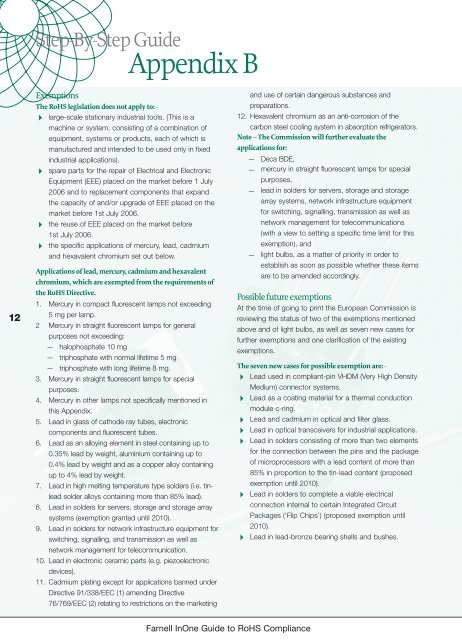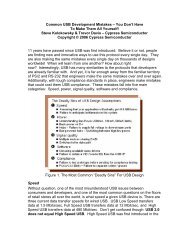RoHS kompatible produkter - Farnell
RoHS kompatible produkter - Farnell
RoHS kompatible produkter - Farnell
You also want an ePaper? Increase the reach of your titles
YUMPU automatically turns print PDFs into web optimized ePapers that Google loves.
12<br />
Step-By-Step Guide<br />
Appendix B<br />
Exemptions<br />
The <strong>RoHS</strong> legislation does not apply to: -<br />
large-scale stationary industrial tools. (This is a<br />
machine or system, consisting of a combination of<br />
equipment, systems or products, each of which is<br />
manufactured and intended to be used only in fixed<br />
industrial applications).<br />
spare parts for the repair of Electrical and Electronic<br />
Equipment (EEE) placed on the market before 1 July<br />
2006 and to replacement components that expand<br />
the capacity of and/or upgrade of EEE placed on the<br />
market before 1st July 2006.<br />
the reuse of EEE placed on the market before<br />
1st July 2006.<br />
the specific applications of mercury, lead, cadmium<br />
and hexavalent chromium set out below.<br />
Applications of lead, mercury, cadmium and hexavalent<br />
chromium, which are exempted from the requirements of<br />
the <strong>RoHS</strong> Directive.<br />
1. Mercury in compact fluorescent lamps not exceeding<br />
5 mg per lamp.<br />
2 Mercury in straight fluorescent lamps for general<br />
purposes not exceeding:<br />
— halophosphate 10 mg<br />
— triphosphate with normal lifetime 5 mg<br />
— triphosphate with long lifetime 8 mg.<br />
3. Mercury in straight fluorescent lamps for special<br />
purposes.<br />
4. Mercury in other lamps not specifically mentioned in<br />
this Appendix.<br />
5. Lead in glass of cathode ray tubes, electronic<br />
components and fluorescent tubes.<br />
6. Lead as an alloying element in steel containing up to<br />
0.35% lead by weight, aluminium containing up to<br />
0.4% lead by weight and as a copper alloy containing<br />
up to 4% lead by weight.<br />
7. Lead in high melting temperature type solders (i.e. tinlead<br />
solder alloys containing more than 85% lead).<br />
8. Lead in solders for servers, storage and storage array<br />
systems (exemption granted until 2010).<br />
9. Lead in solders for network infrastructure equipment for<br />
switching, signalling, and transmission as well as<br />
network management for telecommunication.<br />
10. Lead in electronic ceramic parts (e.g. piezoelectronic<br />
devices).<br />
11. Cadmium plating except for applications banned under<br />
Directive 91/338/EEC (1) amending Directive<br />
76/769/EEC (2) relating to restrictions on the marketing<br />
<strong>Farnell</strong> InOne Guide to <strong>RoHS</strong> Compliance<br />
and use of certain dangerous substances and<br />
preparations.<br />
12. Hexavalent chromium as an anti-corrosion of the<br />
carbon steel cooling system in absorption refrigerators.<br />
Note – The Commission will further evaluate the<br />
applications for:<br />
— Deca BDE,<br />
— mercury in straight fluorescent lamps for special<br />
purposes,<br />
— lead in solders for servers, storage and storage<br />
array systems, network infrastructure equipment<br />
for switching, signalling, transmission as well as<br />
network management for telecommunications<br />
(with a view to setting a specific time limit for this<br />
exemption), and<br />
— light bulbs, as a matter of priority in order to<br />
establish as soon as possible whether these items<br />
are to be amended accordingly.<br />
Possible future exemptions<br />
At the time of going to print the European Commission is<br />
reviewing the status of two of the exemptions mentioned<br />
above and of light bulbs, as well as seven new cases for<br />
further exemptions and one clarification of the existing<br />
exemptions.<br />
The seven new cases for possible exemption are: -<br />
Lead used in compliant-pin VHDM (Very High Density<br />
Medium) connector systems.<br />
Lead as a coating material for a thermal conduction<br />
module c-ring.<br />
Lead and cadmium in optical and filter glass.<br />
Lead in optical transceivers for industrial applications.<br />
Lead in solders consisting of more than two elements<br />
for the connection between the pins and the package<br />
of microprocessors with a lead content of more than<br />
85% in proportion to the tin-lead content (proposed<br />
exemption until 2010).<br />
Lead in solders to complete a viable electrical<br />
connection internal to certain Integrated Circuit<br />
Packages (‘Flip Chips’) (proposed exemption until<br />
2010).<br />
Lead in lead-bronze bearing shells and bushes.






